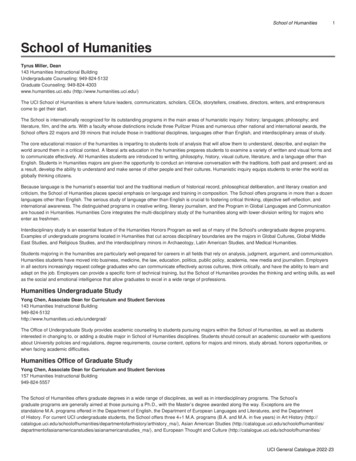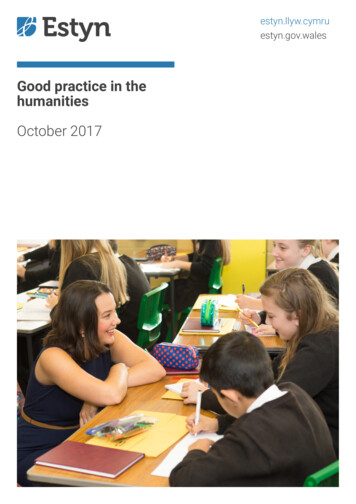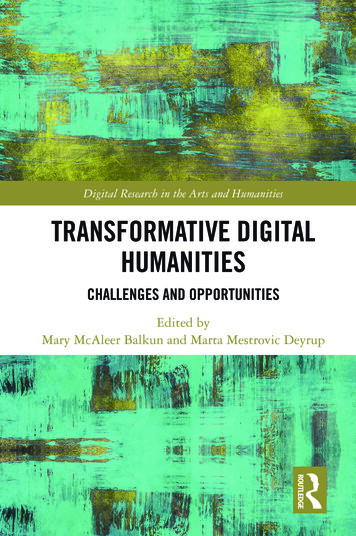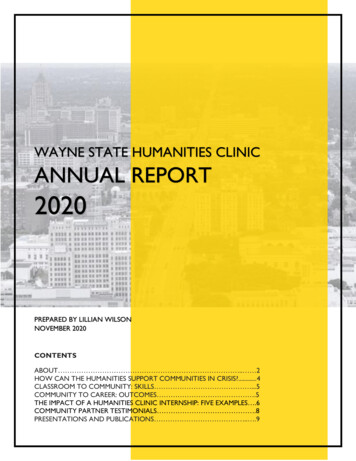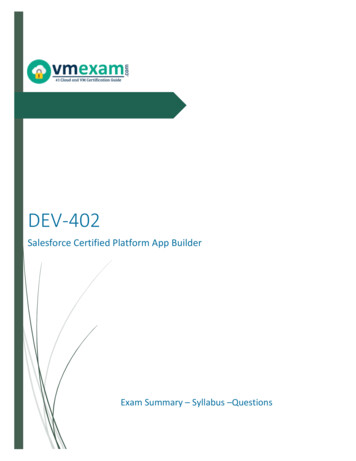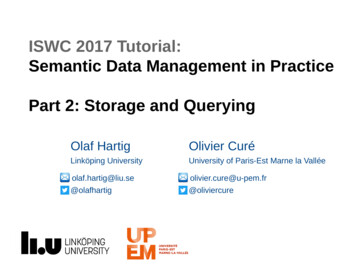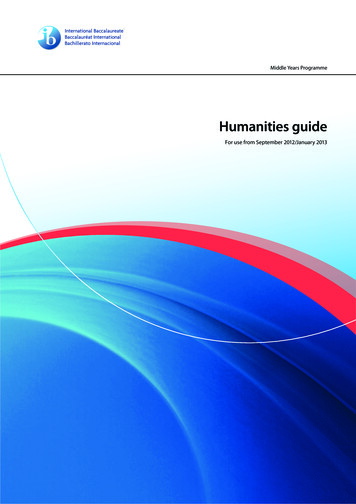
Transcription
Middle Years ProgrammeHumanities guideFor use from September 2012/January 2013
Middle Years ProgrammeHumanities guideFor use from September 2012/January 2013
Middle Years ProgrammeHumanities guidePublished February 2012Published on behalf of the International Baccalaureate Organization, a not-for-profiteducational foundation of 15 Route des Morillons, 1218 Le Grand-Saconnex, Geneva,Switzerland by theInternational Baccalaureate Organization (UK) LtdPeterson House, Malthouse Avenue, Cardiff GateCardiff, Wales CF23 8GLUnited KingdomPhone: 44 29 2054 7777Fax: 44 29 2054 7778Website: www.ibo.org International Baccalaureate Organization 2012The International Baccalaureate Organization (known as the IB) offers three high-qualityand challenging educational programmes for a worldwide community of schools, aimingto create a better, more peaceful world. This publication is one of a range of materialsproduced to support these programmes.The IB may use a variety of sources in its work and checks information to verify accuracyand authenticity, particularly when using community-based knowledge sources such asWikipedia. The IB respects the principles of intellectual property and makes strenuousefforts to identify and obtain permission before publication from rights holders of allcopyright material used. The IB is grateful for permissions received for material usedin this publication and will be pleased to correct any errors or omissions at the earliestopportunity.All rights reserved. No part of this publication may be reproduced, stored in a retrievalsystem, or transmitted, in any form or by any means, without the prior written permissionof the IB, or as expressly permitted by law or by the IB’s own rules and policy. Seehttp://www.ibo.org/copyright.IB merchandise and publications can be purchased through the IB store athttp://store.ibo.org. General ordering queries should be directed to the Sales andMarketing Department in Cardiff.Phone: 44 29 2054 7746Fax: 44 29 2054 7779Email: sales@ibo.orgInternational Baccalaureate, Baccalauréat International and Bachillerato Internacionalare registered trademarks of the International Baccalaureate Organization.Printed in the United Kingdom by Antony Rowe Ltd, Chippenham, WiltshireMYP289
IB mission statementThe International Baccalaureate aims to develop inquiring, knowledgeable and caring young people who help tocreate a better and more peaceful world through intercultural understanding and respect.To this end the organization works with schools, governments and international organizations to developchallenging programmes of international education and rigorous assessment.These programmes encourage students across the world to become active, compassionate and lifelong learnerswho understand that other people, with their differences, can also be right.IB learner profileThe aim of all IB programmes is to develop internationally minded people who, recognizing their commonhumanity and shared guardianship of the planet, help to create a better and more peaceful world.IB learners strive to be:InquirersThey develop their natural curiosity. They acquire the skills necessary to conduct inquiryand research and show independence in learning. They actively enjoy learning and thislove of learning will be sustained throughout their lives.KnowledgeableThey explore concepts, ideas and issues that have local and global significance. In sodoing, they acquire in-depth knowledge and develop understanding across a broad andbalanced range of disciplines.ThinkersThey exercise initiative in applying thinking skills critically and creatively to recognize andapproach complex problems, and make reasoned, ethical decisions.CommunicatorsThey understand and express ideas and information confidently and creatively in morethan one language and in a variety of modes of communication. They work effectivelyand willingly in collaboration with others.PrincipledThey act with integrity and honesty, with a strong sense of fairness, justice and respectfor the dignity of the individual, groups and communities. They take responsibility fortheir own actions and the consequences that accompany them.Open-mindedThey understand and appreciate their own cultures and personal histories, and are opento the perspectives, values and traditions of other individuals and communities. They areaccustomed to seeking and evaluating a range of points of view, and are willing to growfrom the experience.CaringThey show empathy, compassion and respect towards the needs and feelings of others.They have a personal commitment to service, and act to make a positive difference to thelives of others and to the environment.Risk-takersThey approach unfamiliar situations and uncertainty with courage and forethought, andhave the independence of spirit to explore new roles, ideas and strategies. They are braveand articulate in defending their beliefs.BalancedThey understand the importance of intellectual, physical and emotional balance toachieve personal well-being for themselves and others.ReflectiveThey give thoughtful consideration to their own learning and experience. They are ableto assess and understand their strengths and limitations in order to support their learningand personal development. International Baccalaureate Organization 2007
ContentsIntroduction 1How to use this guide 1Humanities in the MYP 2Rationale 2MYP humanities within the IB continuum 3Aims 4Objectives: Year 5 5Assessment criteria: Year 5 7Interim objectives: Year 3 15Interim assessment criteria: Year 3 16Interim objectives: Year 1 22Interim assessment criteria: Year 1 23Objective–criteria alignment 27Assessment in the MYP 28Moderation 30Monitoring of assessment Guidance for teaching and learning in humanities 3537Requirements 37Humanities course structure and implementation 38Developing conceptual understanding through inquiry in humanities 40Special educational needs in the MYP 46The role of language across the curriculum 48The role of the librarian in the MYP 51Information and communication technology 53Academic honesty 55Appendices 57Objective overview 57Assessment criteria overview 59Humanities glossary 67Bibliography 68Humanities guide
IntroductionHow to use this guideThis guide is for use from September 2012 or January 2013, depending on the start of the school year, andfor first use in final assessment in June 2013 or December 2013.This document provides the framework for teaching and learning in humanities in the IB Middle YearsProgramme (MYP) and must be read and used in conjunction with the document MYP: From principles intopractice (August 2008).This guide will give both teachers and students clear aims and objectives for MYP humanities. It includesconceptual and skill requirements of the course, in addition to details of final assessment requirements, aswell as interim objectives and assessment criteria for years 3 and 1 of the MYP.IB-produced teacher support material complements this guide and includes assessed pieces of studentwork.AcknowledgmentThis guide has been produced in collaboration with MYP educators from each of the IB regions, who havebeen involved in the following ways: providing feedback and advice from schools and workshops providing verbal and written participation at curriculum review and development meetings providing verbal and written comments on draft versions of the guide trialling sections of the guide.The IB wishes to thank the educators and associated schools for generously contributing time and resourcesto the production of this guide.Humanities guide1
Humanities in the MYPRationaleMYP humanities encourages learners to respect and understand the world around them and equips themwith a skills base appropriate for a learner in the 21st century. MYP humanities involves inquiring intohistorical, contemporary, geographical, political, social, economic, religious, technological and culturalcontexts that influence and have an impact on individuals, societies and environments. This encourageslearners, both students and teachers, to consider varied local and global contexts. MYP humanities definesitself as incorporating disciplines traditionally found in the humanities, such as history and philosophy,as well as disciplines found in the social sciences, such as economics, geography, sociology and politics.Through the MYP humanities framework, knowledge and conceptual understanding, as well as thinkingcritically and communication, contribute to the development of the student as a whole.All subject groups in the MYP share a common foundation through the attributes of the InternationalBaccalaureate (IB) learner profile and with the fundamental concepts of the MYP—holistic learning,intercultural awareness and communication.MYP humanities can be delivered in different ways: as discrete subjects such as geography, history, economics, politics or psychology as a course of modules in different humanities subjects as an integrated humanities subject group course.The section in this guide “Humanities course structure and implementation” provides further informationabout the structure of humanities courses in a school.2Humanities guide
Humanities in the MYPMYP humanities within the IB continuumMYP humanities builds on learning that students experience during their time in the IB PrimaryYears Programme (PYP). The PYP develops knowledge, conceptual understanding and skills throughtransdisciplinary units of inquiry, which include social studies. The PYP identifies eight key concepts assignificant for transdisciplinary units of inquiry: form, function, causation, change, connection, perspective,responsibility, reflection. Students’ experience of exploring these key concepts in the PYP can help preparethem for developing their understanding of the key concepts identified in MYP humanities: change, time/place/space, global interactions and systems.MYP humanities aims to build on PYP social studies and to challenge students to look beyond theirunderstanding of their immediate time, place and culture. The knowledge component of PYP social studiesis arranged into five strands: human systems and economic activities, social organization and culture,continuity and change through time, human and natural environments, and resources and the environment.These strands are concept-driven and are inextricably linked to each other. These five strands can provideuseful connections to MYP humanities key concepts and the areas of interaction.The aims and objectives of MYP humanities provide a bridge to the Diploma Programme subject group3, individuals and societies. One of the Diploma Programme group 3 aims is to encourage the systematicand critical study of: human experience and behaviour; physical, economic and social environments; andthe history and development of social and cultural institutions. Students further develop the capacityto identify, to analyse critically and to evaluate theories, concepts and arguments about the nature andactivities of the individual and society. They collect, describe and analyse data used in studies of society, testhypotheses, and interpret complex data and source materials. In MYP humanities, students will have beendeveloping cognitive and procedural skills at age-appropriate levels throughout the programme, whiledeveloping their conceptual understanding in humanities.Humanities guide3
Humanities in the MYPAimsThe aims of all MYP subjects state what a teacher may expect to teach and what a student may expect toexperience and learn. These aims, therefore, suggest how the student may be changed by the learningexperience.The aims of the teaching and learning of MYP humanities are to encourage and enable the student to: appreciate the range of human and environmental commonalities and diversities understand the interactions and interdependence of individuals, societies and environments indifferent contexts understand how both environmental and human systems operate and evolve over time identify and develop a concern for human and environmental well-being act upon opportunities to be a responsible global citizen develop effective inquiry skills to achieve conceptual understanding in humanities.4Humanities guide
Humanities in the MYPObjectives: Year 5The objectives of any MYP subject state the specific targets that are set for learning in the subject. Theydefine what the student will be able to accomplish as a result of studying the subject.These objectives relate directly to the assessment criteria found in the “Assessment criteria” sections.Each objective is elaborated by several bullet-pointed strands. All strands in each objective shouldbe met in each year of the programme, at the appropriate level. Interim objectives are provided foryears 3 and 1 in later sections of the guide.A Knowing and understandingKnowledge and understanding is fundamental to studying humanities and forms the base from which toexplore concepts and develop skills. Knowledge is both factual and conceptual and provides the foundationfor thinking critically.At the end of the course, the student should be able to: use humanities terminology in context demonstrate knowledge and understanding of subject-specific content and concepts throughdeveloped descriptions, explanations and examples.B InvestigatingThe development of investigative skills in humanities is an integral part of the inquiry cycle. It enablesstudents to plan and carry out research and/or fieldwork as individuals or in a group.Students should be able to demonstrate investigative skills throughout the humanities course to anincreasing level of sophistication. The focus is placed on acquiring systematic research skills and processesassociated with the craft of each humanities discipline.As part of or during this process, students might reappraise methods and/or research question(s) and makerecommendations for improving the process and act on these where appropriate. This will be part of theformative assessment process and is not explicitly referred to in the objective strands below.Activities that allow students to develop investigative skills include, but are not limited to: research essays,fieldwork investigations, web quests, problem-solving tasks, role plays and group investigations.At the end of the course, the student should be able to: formulate a clear and focused research question formulate and follow an action plan to investigate a research question use methods accurately to collect and record information consistent with the research question effectively address the research question.Humanities guide5
Objectives: Year 5C Thinking criticallyThe ability to think critically in humanities is vital in developing a deeper understanding of the subjectand its concepts. The objective strands highlighted in “Thinking critically” build on the knowledge-baseof humanities and are an integral part of the inquiry cycle. Students should be able to demonstrate theseobjective strands throughout the humanities course to an increasing level of sophistication.At the end of the course, the student should be able to: analyse concepts, events, issues, models and arguments analyse and evaluate a range of sources in terms of origin and purpose, recognizing values andlimitations interpret different perspectives and their implications synthesize information in order to make valid, well-supported arguments.D CommunicatingStudents should be able to demonstrate the ability to use a variety of media to organize and communicatetheir factual and conceptual learning. These formats include, but are not limited to: written reports, oralpresentations, cartoons, storyboards, maps, diagrams, flow charts, PowerPoint presentations, podcasts,animations and videos.Students should be able to demonstrate communication throughout the humanities course to an increasinglevel of sophistication.At the end of the course, the student should be able to: communicate information and ideas using an appropriate style for the audience and purpose structure information and ideas in a way that is appropriate to the specified format document sources of information using a recognized convention.6Humanities guide
Humanities in the MYPAssessment criteria: Year 5Please note that the assessment criteria in this guide are for first use in final assessment in June 2013 orDecember 2013 depending on the school year.The following assessment criteria have been established by the IB for humanities in the MYP. All finalassessment in the final year of the MYP must be based on these assessment criteria even if schools are notregistering students for IB-validated grades and certification.Criterion AKnowing and understandingMaximum 8Criterion BInvestigatingMaximum 8Criterion CThinking criticallyMaximum 8Criterion DCommunicatingMaximum 8For each assessment criterion, a number of band descriptors are defined. These describe a range ofachievement levels with the lowest represented as 0.The descriptors concentrate on positive achievement, although failure to achieve may be included in thedescription for the lower levels.Humanities guide7
Assessment criteria: Year 5Criterion A: Knowing and understandingMaximum: 8Students should be able to: use humanities terminology in context demonstrate knowledge and understanding of subject-specific content and concepts throughdeveloped descriptions, explanations and examples.Achievement level01–23–45–67–8Level descriptorThe student does not reach a standard described by any of the descriptorsbelow.The student: makes a limited attempt to use some relevant terminology demonstrates basic knowledge and understanding of content andconcepts with simple descriptions and/or examples.The student: uses terminology that is accurate and/or appropriate demonstrates knowledge and understanding of content andconcepts through adequate descriptions, explanations or examples.The student: uses a range of terminology accurately and appropriately demonstrates good knowledge and understanding of content andconcepts through accurate descriptions, explanations and examples.The student: uses a wide range of terminology accurately and appropriately demonstrates detailed knowledge and understanding of contentand concepts through developed and accurate descriptions,explanations and examples.Command terms and MYP definitions8UseApply knowledge or rules to put theory into practice.DemonstrateProve or make clear by reasoning or evidence, illustrating with examples orpractical application.Humanities guide
Assessment criteria: Year 5Criterion B: InvestigatingMaximum: 8Students should be able to: formulate a clear and focused research question formulate and follow an action plan to investigate a research question use methods accurately to collect and record information consistent with the research question effectively address the research question.Achievement level01–23–45–67–8Humanities guideLevel descriptorThe student does not reach a standard described by any of the descriptorsbelow.The student: formulates a very general research question formulates and follows a limited action plan to investigate a researchquestion collects and records limited information not always consistent withthe research question makes a limited attempt to address the research question.The student: formulates an adequate research question formulates and follows a partial action plan to investigate a researchquestion uses a method or methods to collect and record some informationconsistent with the research question partially addresses the research question.The student: formulates a clear research question formulates and follows a satisfactory action plan to investigate aresearch question uses methods to collect and record appropriate informationconsistent with the research question satisfactorily addresses the research question.The student: formulates a clear and focused research question formulates and follows a detailed action plan to investigate aresearch question uses methods accurately to collect and record appropriate andvaried information consistent with the research question effectively addresses the research question.9
Assessment criteria: Year 5Notes When defining a “clear and focused research question” the following elements can beconsidered: relevance, manageability, originality, ability to be assessed, of interest to thestudent and based in the subject. Students are not expected to formulate a research questionin all cases that objective B is addressed; this can be supplied by the teacher. However, studentsmust be given opportunities to formulate research questions at some stage during year 5.Research questions might also be formulated at the end of an investigation when studentshave developed their knowledge of the topic under consideration. The research questionmight also be formulated as a research statement. The action plan refers to the steps and information that the student defines in order tocomplete the investigation; it does not specifically refer to an essay plan, although this mightbe included in the overall action plan. Methods to collect information include, but are not limited to: selection of sources (type andrange); questionnaires; surveys; interviews; observation; experiments; measurement; use ofstatistics and databases; formulation of questions. Methods to record information (electronic or paper), include but are not limited to: note-takingand summarizing; production of tables, graphs, maps, checklists; production of MindMaps ;indexing; creation of visuals such as timelines; production of databases.Command terms and MYP definitionsFormulateExpress precisely and systematically the relevant concept(s) or argument(s).InvestigateObserve, study, or make a detailed and systematic examination, in order toestablish facts and reach new conclusions.UseApply knowledge or rules to put theory into practice.10Humanities guide
Assessment criteria: Year 5Criterion C: Thinking criticallyMaximum: 8Students should be able to: analyse concepts, events, issues, models and arguments analyse and evaluate a range of sources in terms of origin and purpose, recognizing values andlimitations interpret different perspectives and their implications synthesize information in order to make valid, well-supported arguments.Achievement level01–23–45–6Humanities guideLevel descriptorThe student does not reach a standard described by any of the descriptorsbelow.The student: makes a limited attempt to analyse concepts, events, issues, modelsor arguments describes some sources in terms of origin and purpose andrecognizes some values and limitations identifies different perspectives makes connections between information in a limited attempt tomake arguments.The student: completes a simple analysis of concepts, events, issues, models orarguments completes a simple analysis and/or evaluation of some sources interms of origin and purpose, recognizing values and limitations identifies different perspectives and their implications makes connections between information to make simple arguments.The student: completes a satisfactory analysis of concepts, events, issues, modelsor arguments satisfactorily analyses and/or evaluates a range of sources in termsof origin and purpose, recognizing values and limitations interprets different perspectives and their implications synthesizes information to make valid arguments.11
Assessment criteria: Year 5Achievement level7–8Level descriptorThe student: completes a detailed analysis of concepts, events, issues, models orarguments effectively analyses and evaluates a range of sources in terms oforigin and purpose, recognizing values and limitations thoroughly interprets a range of different perspectives and theirimplications synthesizes information to make valid, well-supported arguments.Command terms and MYP definitionsAnalyseBreak down in order to bring out the essential elements or structure. To identifyparts and relationships, and to interpret information to reach conclusions.DescribeGive a detailed account or picture of a situation, event, pattern or process.EvaluateAssess the implications and limitations; make judgments about the ideas, works,solutions or methods in relation to selected criteria.IdentifyProvide an answer from a number of possibilities. Recognize and state briefly adistinguishing fact or feature.InterpretUse knowledge and understanding to recognize trends and draw conclusionsfrom given information.PresentOffer for display, observation, examination or consideration.SynthesizeCombine different ideas in order to create new understanding.12Humanities guide
Assessment criteria: Year 5Criterion D: CommunicatingMaximum: 8Students should be able to: communicate information and ideas using an appropriate style for the audience and purpose structure information and ideas in a way that is appropriate to the specified format document sources of information using a recognized convention.Achievement level01–23–45–67–8Humanities guideLevel descriptorThe student does not reach a standard described by any of the descriptorsbelow.The student: communicates information and ideas by attempting in a limitedway to use a style that is appropriate to the audience and purpose makes a limited attempt to structure information and ideas in a waythat is appropriate to the specified format makes a limited attempt to document sources of information.The student: communicates information and ideas by using a style that issometimes appropriate to the audience and purpose structures information and ideas in a way that is sometimesappropriate to the specified format sometimes documents sources of information using a recognizedconvention.The student: communicates information and ideas by using a style that is oftenappropriate to the audience and purpose structures information and ideas in a way that is often appropriate tothe specified format often documents sources of information using a recognizedconvention.The student: communicates information and ideas effectively by using a style thatis consistently appropriate to the audience and purpose structures information and ideas in a way that is consistentlyappropriate to the specified format consistently documents sources of information using a recognizedconvention.13
Assessment criteria: Year 5Notes Schools must ensure that there is a set of recognized conventions for students to adhere towhen documenting sources. These might be a set of conventions developed by the school. When submitting samples for moderation or monitoring of assessment, at least one taskmust allow students to show evidence of documenting sources according to a recognizedconvention.Command term and MYP definitionDocument14Credit sources of information used by referencing (or citing) following onerecognized referencing system. References should be included in the text andalso at the end of the piece of work in a reference list or bibliography.Humanities guide
Humanities in the MYPInterim objectives: Year 3The interim year 3 objectives are for recommended use; however, schools may choose to develop their ownobjectives based on the year 5 objectives.A Knowing and understanding Use humanities terminology in context Demonstrate knowledge and understanding of subject-specific content and concepts, appropriate tothe age level, using descriptions, explanations and examplesB Investigating Formulate a clear and focused research question Follow an action plan to investigate a research question Use methods accurately to collect and record information consistent with the research question Effectively address the research questionC Thinking critically Analyse concepts, events, issues, models and/or arguments Analyse and evaluate a range of sources in terms of origin and purpose, recognizing values andlimitations Recognize different perspectives and their implications Make connections between information to make valid, well-supported argumentsD Communicating Communicate information and ideas using an appropriate style for the audience and purpose Structure information and ideas in a way that is appropriate to the specified format Create a list of sources of information according to the task instructionsHumanities guide15
Humanities in the MYPInterim assessment criteria: Year 3The interim year 3 assessment criteria are for recommended use; however, schools may choose to developtheir own assessment criteria at an age-appropriate level for year 3 based on the year 3 objectives.Criterion A: Knowing and understandingMaximum: 8Students should be able to: use humanities terminology in context demonstrate knowledge and understanding of subject-specific content and concepts, appropriate tothe age level, using descriptions, explanations and examples.Achievement level01–23–45–67–8Level descriptorThe student does not reach a standard described by any of the descriptors below.The student: makes a limited attempt to use some relevant terminology demonstrates basic knowledge and understanding of content andconcepts through some descriptions and/or examples.The student: uses some humanities terminology appropriately demonstrates knowledge and understanding of content andconcepts through simple descriptions, explanations and examples.The student: uses relevant humanities terminology accurately demonstrates good knowledge and understanding of content andconcepts through descriptions, explanations and examples.The student: uses a range of humanities terminology accurately and appropriately demonstrates detailed knowledge and understanding of content andconcepts through thorough descriptions, explanations and examples.Command terms and MYP definitionsUseApply knowledge or rules to put theory into practice.DemonstrateProve or make clear by reasoning or evidence, illustrating with examples orpractical application.16Humanities guide
Interim assessment criteria: Year 3Criterion B: InvestigatingMaximum: 8Students should be able
This document provides the framework for teaching and learning in humanities in the IB Middle Years Programme (MYP) and must be read and used in conjunction with the document From principles into MYP: practice (August 2008). This guide will give both teachers and students clear aims and objectives for MYP humanities. It includes

